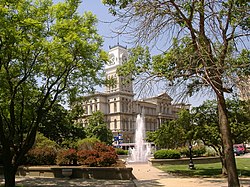Louisville City Hall Complex | |
 | |
| Location | Louisville, Kentucky |
|---|---|
| Coordinates | 38°15′17″N 85°45′38″W / 38.25472°N 85.76056°W |
| Built | 1873 |
| Architect | Multiple |
| Architectural style |
Beaux Arts Second Empire Romanesque Revival |
| NRHP reference No. | 76000905 [1] |
| Added to NRHP | September 1, 1976 |
Louisville City Hall is a registered historic building in Louisville, Kentucky, placed on the National Register of Historic Places in 1976. Completed in 1873 to house the Louisville city government, the structure is located at 601 West Jefferson Street in what became Downtown Louisville, the center of the city's civic district.
Since the merger of the former City of Louisville with Jefferson County, Kentucky, it now primarily houses the offices and chambers of the Louisville Metro Council. The former Jefferson County Courthouse, now known as Louisville Metro Hall, is now primarily home to the offices of the metro mayor of Louisville.
History
The site was already Louisville's civic center. The first log courthouse was built across the street in 1784, and a brick courthouse stood on the site from 1811 to 1837. Prior to the construction of the City Hall, city government officials shared space with the courthouse. [2]
Before the City Hall's construction, there was no dedicated building for city government, whose officials used space in the county courthouses. [2] The plan was selected by way of a design competition held in 1867 with the winner receiving $500. [2] The contest was won in April 1867 by local architect John Andrewartha and C.S. Mergell. [2] In late summer 1870, the final plans for City Hall construction were made by Andrewartha, who was named managing architect, and architectural firm C.L. Stancliff and Co. [2] The remaining government buildings were demolished before ground was broken on the city hall in 1870. [2] Louisville General Council selected City engineer I.M. St. John to supervise the project. [2]
Indiana Limestone, from White River quarries near Salem, Indiana was used. Construction took place between 1870 and 1873 at a final cost of $464,778. [2] The exterior has been renovated several times but remains unchanged, while the interior has been completely remodeled several times.
A Greco-Roman annex building was built just west of City Hall in 1909. Cornelius Curtin designed it. An 1891 firehouse, the next building down Jefferson Street, was integrated into the complex in 1937. The building housed the city's tax collectors and quickly acquired the name " Sinking Fund Building". [3] By the late 20th century it housed the Inspections, Permits and Licenses Department, which moved out in 2004. All three buildings were added to the National Register of Historic Places as the City Hall Complex in 1976.
Architecture
The building was a striking blend of Italianate and Second Empire styles, both popular at the time in civic buildings. Designs on the building represented the city's outlook in the post- Civil War era, which was very optimistic. The pediment over the main entrance features a relief of the city seal and a train steaming forward past Southern flora with the inscription, "Progress, 1871". Other engravings, over the tympana of the side windows, depict livestock heads, representing the importance of agriculture in Louisville's early history. [2] [4]
It has three full stories had a raised basement. The most prominent feature is the 195-foot four-faced clock tower with mansard roof, not completed until 1876 after an earlier one burned in 1875. The tower included a three-ton bell which rang until 1964, when the clock broke. It was repaired in 1968 but broke in the 1970s. It was repaired in 1991. [2] [5]
Gallery
-
View from Jefferson Square
-
View from further south on 6th Street
-
A view from further southeast of the Hall
-
Louisville City Hall Bell
-
Side Entrance, South Elevation, from Jefferson Street
-
Cast Iron Staircase, Leading from Third Floor to Bell tower
-
Detail of Cast Iron Staircase, Third Floor
-
Detail of window sculptures
References
- Brown, Theodore (1960). Introduction to Louisville Architecture.
- Lebovich, William L. (1984). America's City Halls. ISBN 978-0-89133-115-5.
Notes
- ^ "National Register Information System". National Register of Historic Places. National Park Service. January 23, 2007.
- ^ a b c d e f g h i j Douglas L. Stern. "City Hall." The Encyclopedia of Louisville (2001) (ed. John E. Kleber). University Press of Kentucky: p. 189.
- ^ Gregory A. Luhan, Dennis Domer, and David Mohney. The Louisville Guide (2004). Princeton Architectural Press: p. 122.
- ^ G. E. Kidder Smith, Source Book of American Architecture: 500 Notable Buildings from the 10th Century to the Present (2000). Princeton Architectural Press: p. 193.
- ^ William L. Lebovich and Historic American Buildings Survey. America's City Halls (1984). Preservation Press: p. 64.
External links
- Vintage postcards of City Hall
- Architectural page – includes detail photos
- Pictures of City Hall Louisville Kentucky
- 19th-century buildings and structures in Louisville, Kentucky
- Local landmarks in Louisville, Kentucky
- National Register of Historic Places in Louisville, Kentucky
- Government of Louisville, Kentucky
- City and town halls on the National Register of Historic Places in Kentucky
- Clock towers in Kentucky
- Government buildings completed in 1873
- 1873 establishments in Kentucky
- Beaux-Arts architecture in Kentucky
- Second Empire architecture in Kentucky
- Romanesque Revival architecture in Kentucky







